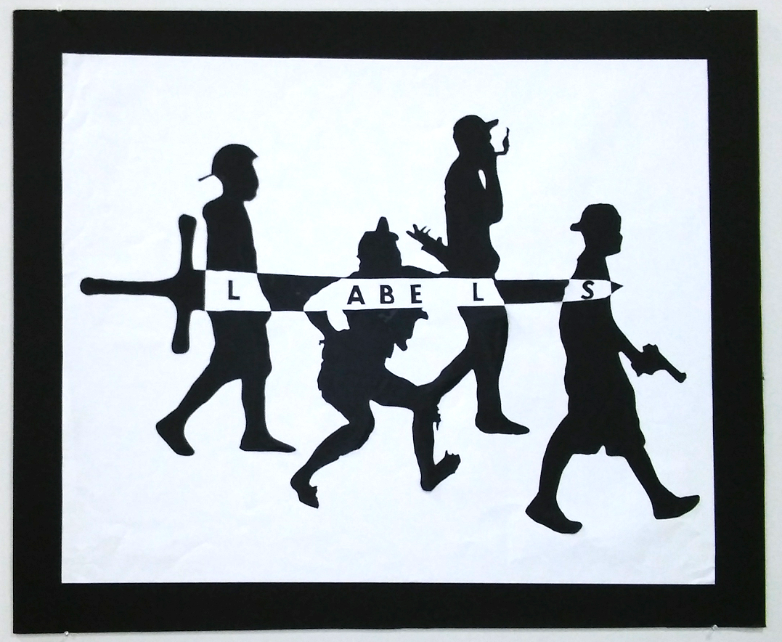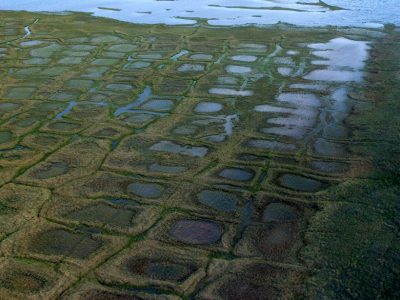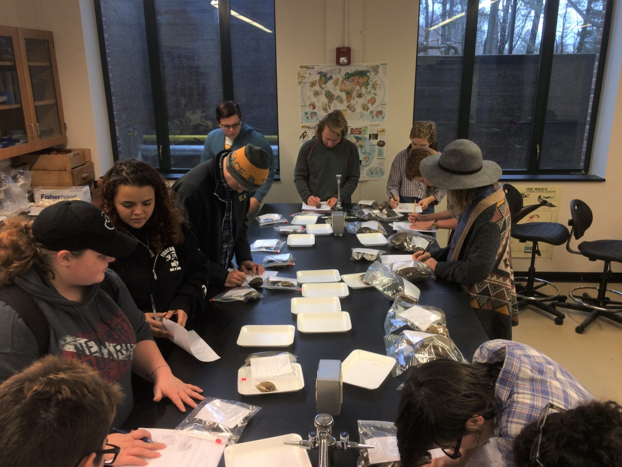Faculty Spotlight: 2017 SOCHE Faculty Excellence Award Winners
Nov 13, 2017Congratulations to Antioch College’s 2017 SOCHE Faculty Excellence Award winners! Beth Bridgeman and Brooke Bryan received awards for Excellence in Service, Kim Landsbergen and Sean Payne received awards for Excellence in Teaching, and Kelly Gallagher & Flavia Sancier-Barbosa received awards for Excellence in Research. The award recipients were recently honored at the SOCHE Faculty Excellence Awards banquet held at the Dayton Art Institute.
Antioch’s Faculty Excellence Awards Committee, comprised of last year’s award winners Emily Steinmetz, Charles Fairbanks, Louise Smith and Michael Casselli, were charged with the difficult work of reviewing applications and selecting winners from among the extremely dedicated and accomplished faculty who had been nominated by the campus community.
Faculty Spotlight: Michael Casselli and the Dayton Visual Arts Center
Jul 31, 2017Michael Casselli, Antioch College Assistant Professor of Sculpture and Installation, shares his talents as an arts professional throughout the region. He has partnered with the Dayton Visual Arts Center (DVAC) as guest curator and juror of Breathing Deeply, Pushing Back: An Exhibition Exploring the Artist as Activist, on view at DVAC August 25 through September 23, 2017.
The exhibition’s concept arose from the conversation that ensued after artwork created by Dayton Regional STEM School students was removed by the City of Dayton two days after it went on display at the Dayton Convention Center in February 2016 due to its political nature. The artwork, created as part of a ninth grade history class, explores experiences of marginalized groups.
Casselli further explains the exhibition, which is meant to open up a dialog to “engage with the issues raised by this powerful work.” He notes:
“I am more interested in the idea of creating commonality and community between each other, recognizing the space we share and developing lasting alliances that will help as we move forward expansively. I am interested in listening, listening deeply and holding my voice so that others can speak. I am interested in pushing back, pushing back against the ideologies that take us further away from each other, pushing back against the actions that reinforce a separation based on being on the ‘winning side,’ pushing back so we can breathe more deeply than we ever have before.”
In addition to artworks by Dayton Regional STEM School students, the show will include pieces by guest artists Carris Adams, Christina Springer, former Antioch College Visiting Assistant Professor of Performance Juan-Si Gonzalez, as well as selections from an open call.
Image: Same People, Different Stereotypes, Dahle, Croake-Uhlman, Arnold
Faculty Spotlight: Katie Kalafut and Little Penguin Tracking for Better Health
Jul 17, 2017Katie Kalafut, Assistant Professor of Psychology at Antioch College, is a behavioral scientist engaged in conducting research outside of the classroom–some of which has recently been highlighted by the Cincinnati Zoo!
Katie has been collaborating with the Cincinnati Zoo and Botanical Garden to better understand and enhance captive animal welfare through behavioral data collection and environmental manipulations. This collaborative effort has produced various research projects for both Katie and Antioch students interested in conducting behavioral research. Katie’s research at the zoo is focused on the identification of the effects of changes in swimming behavior on the prevalence and severity of bumblefoot in Little Blue penguins.
The goal of this research is to quantify the relationship between swimming behavior and the prevalence and severity of bumblefoot lesions. That is, to identify how much swimming is required to reduce/eliminate bumblefoot of varying degrees of severity. This knowledge can inform institutional best practices regarding the amount of swimming appropriate based on the presence or severity of bumblefoot for individual birds. . . Radio Frequency Identification (RF-ID) tags [are used] to collect continuous data on individual penguins. Each penguin is outfitted with an RF-ID tag (about the size a grain of rice) on a wing band. Four antennae that pick up the unique electronic frequency from the tags are strategically placed around the pool. The antenna records the unique tag number (identifying which penguin), which antenna, the date, and the time. This allows to us to ‘see’ exactly when the penguins are entering and exiting the pool.
Learn more about Katie and her work here.
Faculty Spotlight: Kim Landsbergen in Earth & Space Science News
Jun 09, 2017Antioch College Professor Kim Landsbergen was recently quoted in American Geophysical Union journal Earth & Space Science News (Eos) on Trump’s proposed budget, and cuts to the National Science Foundation (NSF). An excerpt follows, or click here to read the full article “Trump Budget Would Set National Science Foundation Back a Decade” by Randy Showstack:
The budget cuts to NSF are the research and development “equivalent of eating intellectual seed corn: shortsighted and self-destructive,” Kim Landsbergen, associate professor of biology and environmental science at Antioch College in Yellow Springs, Ohio, told Eos. “American investment in science and discovery has been the engine of our success since this country began,” Landsbergen said.
Faculty Spotlight: Jeff Romig and a Field Trip with BIO 335: Anatomy and Physiology II
Jun 06, 2017Antioch College’s Biomedical Science program offers students opportunities to experience the discipline up close, enhancing learning through resources like the College’s Human Tissue Library and coordinated visits with area professionals. Dr. Jeff Romig, Visiting Assistant Professor of Human Physiology, recently provided his Spring 2017 BIO 335: Anatomy and Physiology class with their first gross human anatomy/autopsy experience. They took a field trip to the Montgomery County Coroner’s Office and were hosted by Pathologist Bob Shoot, M.D.
Three students, Valerie Benedict, Leandre Niyokwizera, and Isabelle Segadelli, participated in this educational experience, and shared their reflections:
“The first impression of opening the thoracic and abdominal cavity was stunning. I never truly appreciated the vibrancy of the colors and the complexity of organs until they were laid out in that manner. That being said, I also learned that I never want to be a pathologist; the smell is unforgettable and definitely not something I could deal with on a day to day basis.” –Valerie Benedict ‘18
“The trip to the morgue was a great learning experience, even though the scene wasn’t pretty. Seeing the autopsies first hand was a great way to connect all dots from materials learned in the two anatomy and physiology courses [Anatomy and Physiology I & II]. During this visit, I reinforced my anatomical identification skills, as well as physiology. I was able to point what organs belong where and how they contribute to the body in terms of functions. In terms of timing, it was appropriate to go later in the second course because we had learned almost all of the important anatomical structures. If another chance to the morgue was offered, I’d love to go. And I would recommend this to any undergraduate who is in the sciences or premed program.” –Leandre Niyokwizera ‘18
“The visit to the coroner’s office was a great educational experience. I have always found forensic science to be fascinating. One of the interesting things I learned was how each organ was dissected as the doctor looked for the cause of death, as well as the whole process of an autopsy. I appreciated Dr. Shoot’s passion for the work he does. However, today I learned (or reconfirmed to myself) that I find living people more interesting than the dead (not because of the smell).” –Isabelle Segadelli ’18
Faculty Spotlight: Emily Steinmetz
May 11, 2017Inside-Out: Race, Gender, and Citizenship
Assistant Professor of Cultural Anthropology Emily Steinmetz’s Inside-Out course brings together college students and incarcerated people to engage and learn as peers. It was first offered at Antioch College in Spring 2015, meeting on-site at Dayton Correctional Institution (DCI) and comprised half of Antioch students (outside students) and half of incarcerated women (inside students). Below, Dr. Steinmetz discusses and reflects on that first offering:
In this interdisciplinary course we explored the concept of citizenship, paying special attention to the ways that race and gender shape people’s access to the rights and protections conferred by citizen status.
The prison provided a unique context within which to consider citizenship. Prisons act as physical barriers, demarcating spaces of inclusion and exclusion, and much of what happens inside of prisons is invisible to those who spend their time outside the prison walls. Prisons can be understood as “zones of exception,” where the juridical order that governs life on the outside is suspended. The interactions among the inside and outside students, furthermore, provided rich and personal opportunities to consider power, privilege, and differential access to the rights and obligations of citizenship.
From our first meeting at DCI, Antioch students learned how to navigate prison security, leaving behind their phones, wallets, bags, and all of their belongings except for their class materials and a photo ID. They moved through a metal detector, signed the visitor’s log, and traveled through two sally ports to the visitation room where we held our class. On one occasion, the inside students led us on a tour of DCI, offering their own perspectives on the commissary, living quarters, library, gymnasium, chapel, yard, the HVAC training program that is in the process of closing down, and the dog-training program (we watched a brief service dog demonstration). While we did not enter the segregation unit, several inside students told us about their experiences in solitary confinement as we stood in the corridor outside. Finally, we ate breakfast together in the chow hall, where we witnessed the substandard food that a private contractor, serves to incarcerated people.
In accordance with the Inside-Out pedagogy, our class meetings and assignments foregrounded collaboration and intimate conversation. Both inside and outside students encountered their classmates as full and complicated fellow human beings, undoing powerful and prevalent stereotypes about incarcerated people and college students. Inside-Out is designed to break down the “us” and “them” barriers that undergird the project of mass incarceration.
The class culminated in two final projects: 1) an autoethnography, in which students connected their own lived experiences with the theories, concepts, and accounts that we encountered in our readings and class discussions; and 2) an action-based group project that involved inside and outside students working together to research and address an issue that related to our course themes. Group projects focused on:
- Linguistic and disability access in prisons
- Prison orientation and improved access to the rights and responsibilities handbook
- Mandatory minimum sentencing laws
- Prison food and the contracts with vendors
- Prison education programming
- Gendered disparities in pay and work opportunities for incarcerated people, and challenges of employment post-release
Several groups presented proposals for change to prison administrators; the prison orientation group created an informative brochure that DCI has agreed to distribute at the new inmate orientation; an inside student conducted a small qualitative research study with women incarcerated at DCI about the food service; the group studying mandatory minimums launched a letter writing campaign, and sent copies of letters signed by Antioch community members and incarcerated people to elected officials; and one inside student wrote a letter about the criminal justice system that was published in The Record, Antioch College’s newspaper.
During our final class, we celebrated with food that outside students brought to share with the group. Students shared passages from their autoethnographies, received certificates of completion, and inside and outside students had an opportunity to say goodbye.
— Dr. Emily Steinmetz, Assistant Professor of Cultural Anthropology
Faculty Spotlight: Jeff Romig
Mar 01, 2017Jeff Romig, M.D., Visiting Assistant Professor of Human Physiology has formed the Antioch Pre-Professional Association (APPA). The APPA is geared toward students interested in pursuing a post-graduate degree in the Sciences or the Medical Arts (Ph.D., M.D./D.O., D.V.M., D.D.S./D.M.D., Psy.D.), and all are welcome to join.
The APPA gathers to disseminate information regarding the multitude of doctorate programs in the United States and abroad, as well as applications, admission testing, tips for getting accepted to programs and what the life of a graduate student may be like.
Guest speakers are invited to highlight particular graduate and professional programs and the group will have opportunities to visit the OSU and Wright State University schools of medicine and their anatomy labs, OSU’s dental and veterinary schools, and more.
During the first APPA meeting, held on February 24th, guest speaker Dr. Connie Romig, Psychologist and Attorney, spoke about applying to and attending both graduate school and law school. On March 10th, Dr. Scott Millen will be giving a seminar regarding Ph.D. Programs in Microbiology and Molecular Biology and life as a graduate student from his perspective. On March 17th, Jeff will discuss medical school applications, interviewing, and MCATs.
APPA meetings are held on Fridays beginning at 5pm in ASB Room 201. Please RSVP Dr. Jeff Romig at jromig@antiochcollege.edu.
Additionally, on March 8th, Jeff will begin a Wednesday field trip series to the Montgomery County Coroner’s Office for autopsy observations. Contact Dr. Jeff Romig at jromig@antiochcollege.edu for questions and further information.
Faculty Spotlight: Brian Kot
Jan 30, 2017Brian Kot, Assistant Professor of Biology and Environmental Science, accessioned an additional 1,400-plus specimens to Antioch College’s zoological collection.
The specimens were donated by David Keith Metty, semi-professional malacologist and father of Antioch student Emma Metty. This is Mr. Metty’s second donation the zoological collection.
These, and the 230 Molluscs that comprise the first donation, were part of his large, professionally-prepared group of material, collected over 40-plus years. Antioch College is deeply grateful to Mr. Metty for his generosity and contributions of valuable specimens, which have already been used for teaching and research purposes, and will continue to be for many years to come.
Brian and his Conservation Biology (ENVS 330) students recently conducted an exercise with the new shell collection. These upper-division students analyzed and sketched the bivalves and gastropods, and then developed a practice research proposal to address a conservation-based scientific question.

One favorite specimen was the giant washboard mussel (Megalonaias nervosa).
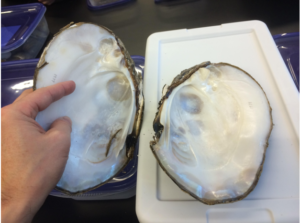
Faculty Spotlight: Kim Landsbergen, Corine Tachtiris and Dean Snyder
Jan 30, 2017Kim Landsbergen, Associate Professor of Biology and Environmental Science, Corine Tachtiris, Assistant Professor of Literature, and Dean Snyder, Assistant Professor of Political Economy, recently took SCI370 and LIT150 students to tour the Ohio State Byrd Polar Climate Research Center (BPCRC), in conjunction with the climate change issues being discussed in class this quarter.
The BPCRC is one of the nation’s recognized places of excellence in climate change science. The co-directors of the lab, Ellen and Lonnie Thompson, are internationally recognized for their climate science, and the many teams of researchers there are studying aspects of climate change around the world, including Tibet, Peruvian glaciers, Greenland, and Antarctica.
Here are photos from the tour:
The group learned about the Tibetan Plateau, referred to as The Third Pole, due to the large amount of (quickly melting) glaciers there. Glacier melt feeds river flow that provides water for more than a billion people in this area, but accelerated melt rates threaten future critical water supplies.
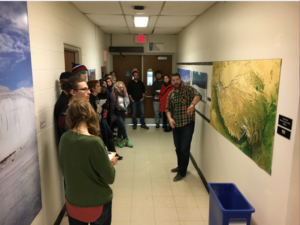
Historic photo of the first all-women’s Antarctic expedition from 1969. Some of the members were affiliated with the OSU BPCRC.
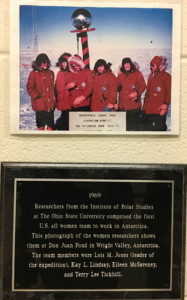
Inside the United States Polar Rock Repository, a resource that contains many rocks from Polar regions where scientists can come to study the geology (without having to go all the way there).
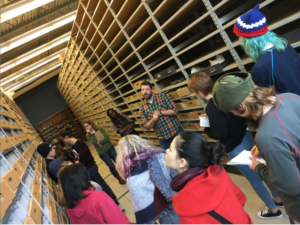
A member of the Class of 2018 holds an ammonite fossil found in Antarctica. It’s a type of invertebrate that went extinct in the KT Mass Extinction event.
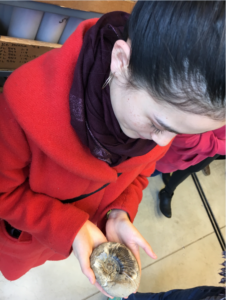
Students enjoying the tour in the deep, deep freeze of the ice core Repository. These cores are from all over the world, from 6 continents.
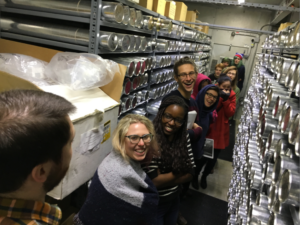
An ice core from the Mt. Kilimanjaro glacier, which is expected to melt entirely by 2020.

Faculty Spotlight: Emily Steinmetz
Jan 25, 2017Congratulations to Emily Steinmetz, Assistant Professor of Cultural Anthropology, the faculty recipient of the 2017 MLK Drum Major for Justice Award. Emily was recognized for her work with the Prison Justice IG and her Inside-Out course, which brings together college students and incarcerated people to engage and learn as peers.
Emily’s Inside-Out course meets at Dayton Correctional Institution (DCI) and is comprised half of Antioch students (outside students) and half of incarcerated women (inside students). The interdisciplinary course explores the concept of citizenship, paying special attention to the ways that race and gender shape people’s access to the rights and protections conferred by citizen status.
The annual MLK Drum Major for Justice Award recognizes those with a strong commitment to social justice, diversity and inclusion. This year, both a faculty and a staff member were recognized.
Steve Duffy, ’77, Library Circulation Specialist, received the staff honor. Duffy has been a vital part of Antioch for four decades and was fundamental to the reopening and revitalization of Antioch College. He was recognized for his generous support of current students and the Alumni of Color chapters.



